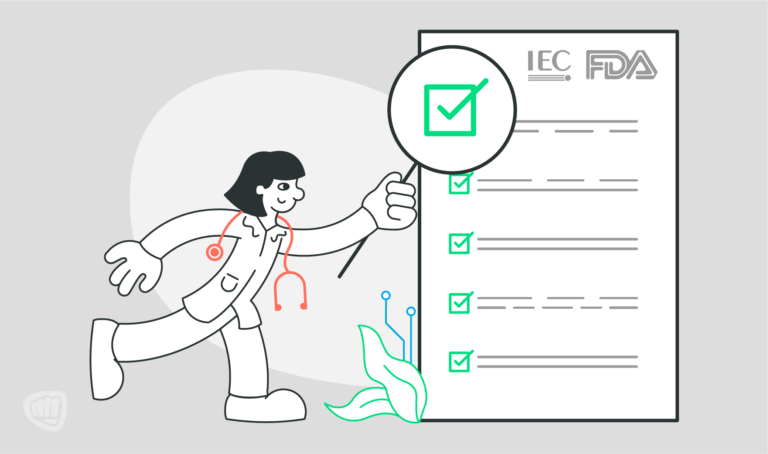Introduction
Testing decisions shape the reliability of your system, the pace of your development, and the safety of the people who depend on your device. It’s not just about what tests you run; it’s about when, where, and why they matter, especially in connected systems, where failure doesn’t stay neatly contained.
The types of testing are well known. The real challenge is knowing how deep to go, where to focus, and when to adapt based on what your system actually does, how it behaves in the real world, and what happens if it fails.
This article dives into how we approach test strategy for connected medical devices, where classification is just a starting point and alignment to risk is what actually protects patients and supports compliance. Whether you’re still planning or preparing for formal verification, the goal is to help you pressure-test your current approach or build something more resilient from the ground up.
The Testing Decision Framework
Many teams start with device classification under IEC 62304, and that’s a solid baseline. But it doesn’t tell you everything. Testing decisions should be shaped by your system, not just what it’s labeled. The table below maps common testing types to software classes, but don’t stop there. IEC 62304 classification provides a baseline and it’s also a key input for aligning your testing approach with regulatory documentation needs.
| Testing Type | Class A Devices | Class B Devices | Class C Devices | Key Decision Factors |
| Static Analysis | Recommended | Strongly Recommended | Mandatory | Always implement as first line of defense regardless of device class |
| Unit Testing | Optional | Recommended | Mandatory | Required for real-time operations or complex algorithms |
| Integration Testing | Recommended | Mandatory | Mandatory | Essential for all connected or multi-component systems |
| Hardware-in-the-loop (HIL) Testing | Recommended | Strongly Recommended | Mandatory | Critical for devices with physical interactions or environmental dependencies |
| Security Testing | Based on connectivity | Mandatory for connected devices | Mandatory with enhanced protocols | Data sensitivity and connectivity determine depth |
This mapping helps establish a foundation. But relying on classification alone can lead to gaps where risk is higher than the class suggests.
Why Risk-Based Testing Matters
A strong test plan doesn’t just list what you’ll do; it explains why you’re doing it and what risk it reduces. That shift in thinking is what separates regulatory minimums from reliable strategies.
Key factors shaping a risk-based approach:
- Device classification: Establishes a baseline.
- System-level risks: Includes connectivity, autonomy, data flow, and usage conditions.
- Timing and scope: Determines how deeply to test and when.
- Ongoing changes: Captures the need to revisit assumptions as the product evolves.
This means understanding your device not just by class, but by context: Does it push updates to the field? Interact with other devices? Make autonomous decisions based on sensor input? These are the questions that determine testing depth and priority.
A Layered Testing Approach
Instead of applying every test to every module, structure your plan around layers, each aligned to risk level, architecture, and impact. This helps keep testing focused where failure would be most costly.
We recommend:
- Core Verification: Static, unit, and integration tests based on architecture.
- Risk-Specific Additions: HIL, fuzz, or extended integration tests where failure likelihood or severity is high.
- Connectivity and Security: Testing around communication channels and external surfaces.
- Change Triggers: Points in development where re-validation is required.
This layered model keeps your effort focused and scalable, ensuring critical risks are always front-loaded.
Comparing Risk in Practice
Classification gets a lot of attention but in the field, it’s rarely the thing that actually defines risk. We’ve seen Class B devices with vastly different stakes based entirely on how they function.
One might be a simple, offline logger with limited logic and no external connections. Its test strategy? Static analysis, some unit tests, light integration work. Just enough to validate basic behavior.
But now take a Class B system that pushes patient data over BLE, handles field updates, and automates dosing decisions. That’s a different ballgame. You’re now dealing with:
- Security-sensitive communication
- Real-time decision-making
- Tight system integration across layers
That kind of connected device calls for a much broader test plan: protocol validation, BLE robustness, security reviews, and HIL testing to simulate real-world failures before they reach the patient.
Same classification. Entirely different exposure. That’s why alignment to real risk, not just class, is what separates a passable test plan from a resilient one.
Where Deeper Testing Makes the Difference
Not all tests pull their weight equally; running everything everywhere isn’t a strategy. The real impact comes from knowing which tests to prioritize based on how your system behaves, where it breaks, and what’s at stake when it does. Here’s how we think about that.
Unit Testing
Unit tests isolate critical logic and expose issues early, before they ripple into larger systems. We’ve found they’re most valuable in devices with:
- Safety-critical calculations
- Real-time data handling
- Complex state machines or input trees
Even if not mandated by classification, unit tests help teams catch the kinds of edge cases and state transitions that become costly to diagnose later. They don’t replace integration, but they do accelerate everything that follows.
Integration Testing
Most failures in connected systems don’t happen inside modules, they happen between them. Integration testing validates how components interact across:
- BLE or cloud sync layers
- Shared system state or timing
- Protocol or API boundaries
We consistently see integration tests surface silent issues that unit testing can’t reach: out-of-order data, mismatched assumptions, and race conditions across platforms. If your device syncs with anything, integration testing needs to come early and run often.
Hardware-in-the-Loop (HIL)
HIL brings hardware into your test loop and surfaces issues mocks can’t reach. It’s especially critical for:
- Connectivity under real RF conditions
- Sensor edge-case validation
- Hardware/firmware timing mismatches
We’ve worked with teams where HIL caught bugs that would’ve only appeared after launch—delayed inputs, retries that failed silently, power-cycle errors. Yes, it’s heavier to implement. But for connected Class II/III systems, it’s the closest thing to seeing field behavior before you’re actually in the field.
Security Testing Tactics
In connected devices, safety and security are intertwined. We’ve helped teams avoid critical failures by prioritizing:
- Encryption and integrity validation across BLE/cloud
- Fuzzing for input sanitation (especially over transport layers)
- Replay protection and spoof resistance for command channels
Security testing isn’t just about what’s stored, it’s about what can be manipulated. We recommend revisiting your attack surface every time the architecture or protocol stack changes.
Key Questions to Guide Your Plan
Before investing time and resources into an in-depth testing effort, you need a clear understanding of what your device actually demands. These questions aren’t theoretical. They’re the same ones regulators, auditors, and your QA team will ask when evaluating whether your test strategy is appropriate to the product’s risk.
Ask yourself:
- What is your device’s IEC 62304 classification?
And does it reflect the actual complexity and risk introduced by the system’s design? - What are the consequences of a failure in the field?
Are there potential safety impacts, data losses, or delayed interventions? - Does your device connect to other systems or networks?
Connectivity increases risk surfaces, particularly when real-time data or security is involved. - Does the device make autonomous decisions or interpret sensor input?
The more software governs action without user intervention, the higher the testing burden. - Will it support field updates, OTA changes, or post-market modifications?
If yes, you’ll need a plan for regression testing and ongoing validation. - Which system components, if they fail, create the greatest risk to safety or reliability?
These components deserve focused, deeper testing, regardless of module size.
Your answers don’t just shape your testing scope, they help prioritize where testing is most critical and time-sensitive. That’s the real purpose of risk alignment.
Structuring Your Testing Plan
A testing strategy is only effective if it reflects how your system actually functions across firmware, applications, and connected services. It’s not just about regulatory coverage or picking the right test types. It’s about applying the right focus, at the right time, with the right level of rigor, based on where the system is most likely to break down.
The more complex or connected your device becomes, the more intentional your test planning needs to be, especially when safety, data integrity, and real-time behavior are at stake.
Planning Around Risk, Timing, and Depth
At a minimum, your testing plan should address three key dimensions:
- What to test (based on risk and architecture)
- When to test it (based on development milestones and integration points)
- How deeply to test (based on complexity, criticality, and real-world behavior)
Start by mapping out where your system is most likely to fail. These are often not individual modules, but boundaries between firmware and mobile apps, between apps and cloud, or anywhere data is handed off. These transitions are common sources of missed assumptions and silent failures.
Once you’ve identified your risk surfaces, assign test depth and frequency to each one. Some areas may need unit tests and static analysis. Others may require full integration scenarios, HIL setups, or security fuzzing. The goal is to right-size the effort to the potential impact.
Supporting Compliance Through Test Strategy
A well-structured testing plan improves reliability and directly supports regulatory deliverables. Aligning test depth and scope to system-level risks creates a traceable rationale for your verification strategy. This makes connecting test evidence to design inputs, risk controls, and regulatory expectations easier under IEC 62304 or ISO 14971. The more explicitly your testing strategy maps to real-world risk, the more defensible and efficient your compliance documentation becomes.
Testing for Connected System Behavior
In connected medical systems, software components rarely operate in isolation. Your firmware may rely on a mobile app to trigger workflows. BLE connections may be interrupted mid-command. Cloud APIs might respond out of order, or not at all.
This means your testing plan also needs to cover:
- Interoperability validation between device, mobile, and cloud.
- Resilience to failure across BLE, transport protocols, and sync logic.
- Data consistency checks across hops, especially when state is shared across systems.
These aren’t tests you run once. They need to be revisited whenever protocols change, versioning shifts, or integration is reworked. In many connected systems, a “passed test” under lab conditions won’t reflect real-world usage unless connectivity behaviors are included in the test environment.
To make this actionable:
- Schedule regression points around firmware + mobile and mobile + cloud sync.
- Validate not just success paths, but failure modes—timeouts, retries, dropped packets.
- Document integration assumptions early and use them to drive test case design.
Testing a connected system means validating how pieces behave together, not just whether they function in isolation. In real-world environments, failures often stem from how components interact across boundaries, not from how they perform on their own. The following scenario illustrates what that kind of system-level testing actually looks like in practice.
Example: Testing a BLE-Connected System End-to-End Consider a BLE-connected device that sends patient vitals to a mobile app, which then uploads data to a cloud platform for clinician review. Testing this system means validating more than just data transmission, it means simulating a BLE disconnection mid-transfer, verifying the mobile app queues and retries the data correctly, confirming the data matches at the cloud endpoint, and ensuring that version mismatches between firmware and app don’t silently cause sync failures. These behaviors should be tested not only under ideal conditions but with deliberate packet loss, power cycles, or out-of-order communication events that mimic field usage.
Scenarios like this evolve, and your test strategy needs to grow with them.
Adapting Your Testing Strategy Over Time
Even a well-designed test plan needs to evolve. The complexity of embedded medical devices makes change inevitable, whether it’s architecture refinements, new clinical feedback, or expanded feature sets.
When any of the following happen, your test plan should be reassessed:
- System architecture changes that affect timing, data flow, or hardware interactions
- New connectivity protocols or data surfaces that introduce security implications
- Shifts in regulatory expectations or internal quality standards
- Product updates post-market, especially if field-updatable or software-driven
Adapting doesn’t mean rewriting everything. It means returning to your risk assumptions, reevaluating what’s most critical, and updating your testing layers to reflect the new shape of the product.
The most effective teams treat the test strategy as a living document. Not static. Not reactive. Just aligned every step of the way with the product it supports.
Testing as a Strategic Advantage
A testing strategy that reflects how your system actually works across devices, apps, and cloud, isn’t just a quality measure. It’s a competitive advantage. Done well, it reduces surprises, lowers long-term cost, strengthens regulatory confidence, and protects the people relying on your product.
This isn’t about overbuilding or overtesting. It’s about investing in the right validation at the right time, based on how your system behaves in the real world, not just how it’s classified on paper.
If your current strategy leans too heavily on regulatory checklists or static assumptions, now’s the time to revisit it. Teams building connected Class II and III systems face evolving risks. The most successful ones plan for that from the start—structuring testing to validate performance across the system, not just within it.
That’s the difference between testing to pass an audit and testing to get your device safely to the people who need it.




